Abstract
Mushroom residues and swine manure are two common types of agricultural waste that are often returned to fields as organic fertilizers. However, the environmental risks of their reclamation, such as heavy metal pollution, have been less studied. To investigate the potential risks of heavy metal contamination in soils and vegetables after continuously applying mushroom residues and swine manure, field experiments of four consecutive vegetable rotations were conducted in the Qingpu District of Shanghai, Southeast China, from 2019 to 2021. The concentrations of heavy metals in soils continuously fertilized with mushroom residues and swine manure gradually increased. The organic matter content in the soils exhibited a significant correlation with the concentrations of Cu, Zn, Pb, and Cd (p < 0.01), suggesting that the increase in heavy metals is attributed to the use of organic waste. In particular, the application of swine manure increased Cu, Zn, Pb, and Cd concentrations in the soils by 118.3%, 54.9%, 57.6%, and 122.2%, respectively. Moreover, the application of organic waste raised the risk of the bioaccumulation of toxic metals, such as Cd, in vegetables. The Cd concentration was significantly and positively correlated with Zn in the edible parts of vegetables (p < 0.05). The recycling of swine manure more significantly enhanced Cd concentrations in the edible parts of green pepper (Capsicum annuum), eggplant (Solanum melongena), Brassica chinensis, and lettuce (Lactuca sativa), which were 2.53, 1.55, 1.66, and 1.62 times that of the non-fertilizer control (CK), respectively. Although the increase in heavy metals in the soils and vegetables was still mild when compared with the set thresholds of soil and food safety after the four vegetable rotations, the trend of increase in toxic heavy metals in the food chain with a continuous application of organic waste should be carefully considered.
1. Introduction
The application of chemical fertilizers is the most commonly used method for increasing the yield of crops [1]. The excessive use of chemical fertilizers, however, often causes soil acidification, the degradation of soil quality, the eutrophication of surface water, and an increasing incidence of crop pests and diseases [2,3,4,5,6]. Reducing the amount of the application of chemical fertilizers is beneficial to improving soil quality, protecting the ecological environment, and reducing greenhouse gas emissions. The increased application of organic manure in fields is highly encouraged to improve the quality of soil and agricultural products [7,8,9,10].
The annual yield of edible fungi in China accounts for more than 70 percent of the world’s total yield, and the number of live pigs in China has reached 680 million in recent years. It is a challenge to properly address the organic waste generated from the production of edible fungi and the breeding of live pigs for the prevention of environmental pollution. Culture bases for growing edible fungi are mostly composed of bits of wood, bran, straw, gypsum, and manure. The waste bases left over from edible fungal cultivation are often called mushroom residues [11], which contain a high amount of mycelium and semi-decomposed cellulose or lignin [12], as well as a high content of extracellular enzymes [13], which are considered to be potential organic fertilizers [14]. Swine manure, enriched in organic matter, nitrogen, and other mineral nutrients, is also commonly used as an organic fertilizer. However, the swine manure derived from pig farms often contains a high amount of toxic heavy metals, antibiotics, and pathogens [15,16], with the contents of Cu and Zn even reaching as high as 1150.1 and 1630.0 mg/kg, respectively [17]. Mushroom residues may also contain a certain amount of heavy metals, salts, and other harmful materials. The contents of toxic metals in some organic fertilizers exceed the thresholds specified by the China National Standards for Food Safety, thus posing a threat to soil and agricultural products [18,19].
Organic waste products that include mushroom residues and swine manure are often recycled and used in fields as organic fertilizers. However, we still do not clearly know whether the harmful substances in these types of waste will enter the food chain through soil–crop systems when they are persistently applied as organic fertilizers for a long time. Vegetables are necessities for human daily life and are sensitive to the soil environment. Toxic heavy metals are easily translocated from soil to the edible parts of vegetables [20,21,22], thus harming human health [23,24]. A severe health problem was observed after eating vegetables harvested from polluted soil for a long time [25]. In our previous work, we also found an increasing risk of heavy metal contamination in rice grains after applying swine manure to paddy fields for four consecutive years [26]. To guarantee food safety, therefore, it is essential to scrutinize the possible accumulation of toxic substances in soil–crop systems after the long-term application of mushroom residues and swine manure.
In this study, field experiments of four consecutive vegetable rotations were conducted in the suburbs of Shanghai from 2019 to 2021, with the continuous application of two kinds of mushroom residues and swine manure as organic fertilizers. We aimed to compare the nutrient efficiency of these organic waste products and assess the possible risks of heavy metal accumulation in soil–vegetable systems. This may help us to find a good solution for the suitable and safe recycling of organic waste.
2. Materials and Methods
2.1. Filed Experiment
Shanghai is located in the Yangtze River Delta of Southeast China, neighboring the East China Sea in the east, and only being 3.2 m above sea level. The climate of the region falls under the subtropical humid monsoon category, with a mean annual temperature of 17.1 °C and a mean annual precipitation of 1223.4 mm. The field experiment’s site is situated in Jinze Town in Qingpu District in the western suburbs of Shanghai, with a geographical position of 31°13′ N latitude and 120°89′ E longitude (Figure 1). The soil of the field was developed from lacustrine and alluvial deposits, the basic features of which are presented in Table 1.
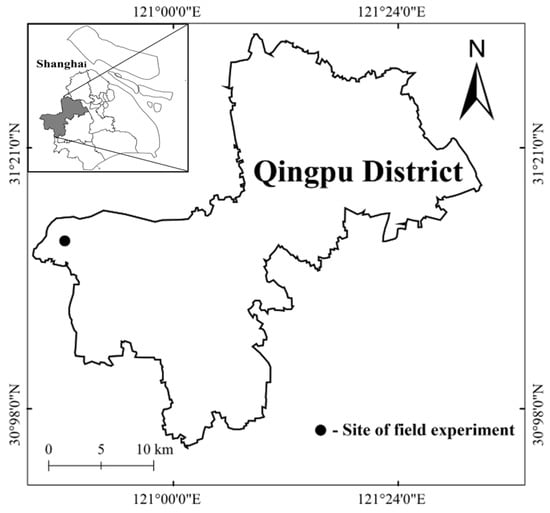
Figure 1.
Sketch map showing the geographical location of the field experiment in the Qingpu District of Shanghai, Southeast China.

Table 1.
Soil background values of the field experiment’s site in the Qingpu District of Shanghai, Southeast China.
Green pepper (Capsicum annuum), eggplant (Solanum melongena), Brassica chinensis, and lettuce (Lactuca sativa) were sequentially cultivated in the experimental field from February 2019 to May 2021. Each plot was 1.2 m × 4.16 m in area, which was separated from the others with 0.5 m wide ditches. There were 12 plots in the field. Four treatments were designed, namely the application of culture residues of Agaricus bisporus and Flammulina velutipes, swine manure treatment, and non-fertilizer control, which were coded as AB, FV, SM, and CK, respectively. All organic waste products were applied as basal fertilizers one week before transplantation. The quantities of the fertilizers and pure nutrients used in all the treatments are illustrated in Table 2. Each treatment was applied in triplicate.

Table 2.
Quantities of the organic fertilizers applied in the treatments in the field experiments.
The vegetable of the first rotation was green pepper (F1), for which seedlings were grown on 15 February 2019, transplanted on 28 April 2019, and harvested on 23 June 2019.
The second rotation was eggplant (F2), for which seedlings were grown on 10 May 2020, transplanted on 22 May 2020, and harvested on 2 August 2020.
The third rotation was Brassica chinensis (F3), for which seedlings were grown on 20 October 2020, transplanted on 1 November 2020, and harvested on 12 January 2021.
The fourth rotation was lettuce (F4), for which seedlings were grown on 20 February 2021, transplanted on 9 March 2021, and harvested on 11 May 2021.
The culture residues of Agaricus bisporus applied in the experiments were obtained from Shanghai Lianzhong Edible Fungi Co. Ltd., located in Jinshan District, Shanghai, China. The original components were rice straw, chicken manure, and gypsum. The culture residues of Flammulina velutipes were obtained from Shanghai Guangming Senyuan Biotechnology Co. Ltd., Fengxian District, Shanghai, China. The original components were corn cob, cottonseed husk, and rice bran. The swine manure used in the experiments was obtained from a pig farm in the suburbs of Shanghai. Two kinds of mushroom residue and swine manure were applied to the field after composting for two weeks. The nutrient and heavy metal concentrations in the organic waste products are illustrated in Table 3.

Table 3.
Contents of nutrients and heavy metals in the organic fertilizers in the field experiments.
2.2. Sampling
The soils and vegetables in the experimental field were sampled shortly before harvesting.
Nine subsamples of soil were evenly collected at each plot with a thickness of 0–20 cm and mixed into one sample. The number of soil samples collected during the four consecutive vegetable rotations was 48 in total. The soil samples were carried to the laboratory, air-dried, crushed, and sieved through 2 mm and 0.159 mm sieves, sequentially, for laboratory analyses [27].
Similarly, nine subsamples of whole vegetable plants were randomly selected and mixed into one plant sample in each plot. The plant samples were washed using deionized water and divided into independent samples of roots and edible parts for chemical analyses [28].
2.3. Chemical Analyses
2.3.1. Physical–Chemical Properties
Organic matter (OM) content was determined using the KCrO4-H2SO4 method. Total nitrogen (TN) was determined using Keyser’s method, and alkali-hydrolyzable nitrogen (AN) was measured using the alkaline diffusion method. Total phosphorus (TP) was analyzed using the acid digestion–phosphomolybdenum blue colorimetry, while the available phosphorus (AP) was extracted with a NaHCO3 solution and analyzed using phosphomolybdenum blue colorimetry. Total potassium (TK) was measured using the acid dissolution–ICP analysis, and available potassium (AK) was extracted with ammonium acetate and analyzed using ICP measurements [29].
2.3.2. Measurements of Heavy Metal Concentrations
About 0.2 g of each soil sample was put into a Teflon crucible and digested using three mixed acids (HNO3-HClO4-HF), which were heated on the digesting plate at 120 °C for 6 h [30]. About 2 g of dried organic manure or 5 g of fresh plant paste was put into a conical beaker and digested using the mixed acids (HNO3-HClO4), which were then heated on the digesting plate at 105 °C for 4 h [31]. After cooling, the digested solutions were volumed and filtered with the membrane. Cu and Zn concentrations in the digested solutions were measured using the inductively coupled plasma spectrometer (ICP-AES: Prodigy model, Leeman Instruments Ltd., Omaha, NE, USA), with a relative standard deviation of less than 3%. Cd and Pb concentrations in the solutions were determined using an atomic absorption spectrophotometer with a graphite furnace (GF-AAS: ZEEnit 600/650, Jena, Germany), with a relative standard deviation of less than 5%.
The bioaccumulation factor (BAF) is often used to assess the bioavailability of toxic metals in soils [32]. The BAF (%) was calculated in this study to evaluate the accumulation of heavy metals in vegetables from the soil. BAF (%) = Cv/Cs × 100%. Cv refers to the content of a certain heavy metal in vegetables; Cs to that in soil.
2.4. Statistical Analyses
All the experimental data were first recorded and analyzed using Microsoft Excel 2010. They were further analyzed using IBM SPSS Statistics 26 and are expressed as the mean ± standard error (n = 3). The differences among the different data were analyzed using an analysis one-way ANOVA, (p < 0.05). Pearson’s correlations were deemed significant at p < 0.05 or p < 0.01. All the illustrations were drawn using Origin 2018 (OriginLab, Northampton, MD, USA).
3. Results
3.1. Variation in Soil Nutrients Caused by Application of the Organic Waste
3.1.1. Content of Organic Matter
The OM content in the soils used in the four vegetable rotations using the three fertilizer treatments showed a gradually increasing trend (Figure 2). At the end of the experiments, the OM contents in the soils after the treatments were significantly higher than CK (p < 0.05), increasing by 43.1%, 49.2%, and 52.9%, respectively. In particular, the OM content in the soil treated with SM reached as high as 37.47 g/kg.
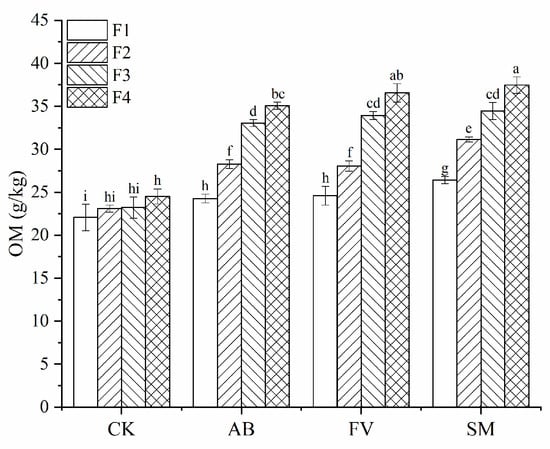
Figure 2.
Organic matter (OM) in the soils using the different treatments during the four vegetable rotations. Different lowercase letters at the top of the data in the same groups indicate significant differences between them at p < 0.05 level. CK, AB, FV, and SM refer to the different treatments. F1, F2, F3, and F4 refer, respectively, to the first, second, third, and fourth rotation of vegetables during the experiments.
3.1.2. Content of Nitrogen
TN and AN contents in the soils treated with AB and SM also showed a gradually increasing trend during the experiments (Figure 3). After the first vegetable rotation, TN and AN contents in the soils using the three fertilizer treatments were significantly higher than those in CK (p < 0.05). Finally, the TN content in soils treated with SM was 1.71 times higher than CK, with 2.05 g/kg, and the AN content in soils treated with FV was 1.57 times higher than CK, with 0.17 g/kg.
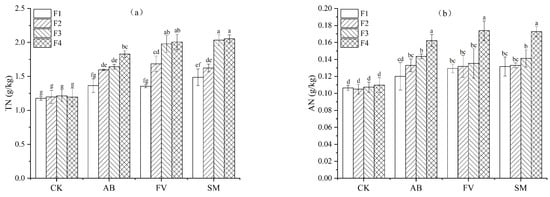
Figure 3.
(a) Total nitrogen (TN) in the soils using the different treatments during the four vegetable rotations; (b) alkali-hydrolyzable nitrogen (AN) in the soils using the different treatments during the four vegetable rotations. Different lowercase letters at the top of the data in the same groups indicate significant differences between them at p < 0.05 level. CK, AB, FV, and SM refer to the different treatments. F1, F2, F3, and F4 refer, respectively, to the first, second, third, and fourth rotation of vegetables during the experiments.
3.1.3. Content of Phosphorus
TP and AP contents in the soils treated with AB, FV, and SM were significantly higher than CK after the first vegetable rotation (p < 0.05). Moreover, TP and AP contents in the soils using the three fertilizer treatments also increased significantly as the experiments continued (Figure 4). For comparison, TP and AP contents in the soils treated with SM increased more significantly. At the end of the experiments, TP and AP contents in the soils treated with SM were 3.21 and 2.45 times higher than CK and also higher than those treated with AB and FV.
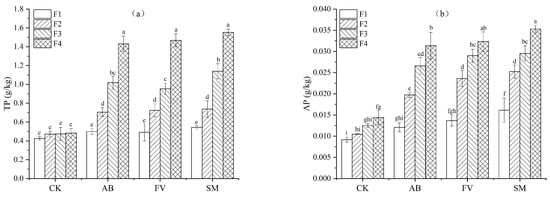
Figure 4.
(a) Total phosphorus (TP) in the soils using the different treatments during the four vegetable rotations; (b) available phosphorus (AP) in the soils using the different treatments during the four vegetable rotations. Different lowercase letters at the top of the data in the same groups indicate significant differences between them at p < 0.05 level. CK, AB, FV, and SM refer to the different treatments. F1, F2, F3, and F4 refer, respectively, to the first, second, third, and fourth rotation of vegetables during the experiments.
3.1.4. Content of Potassium
TK and AK contents in the soils treated with AB, FV, and SM also showed a gradually increasing trend during the four vegetable rotations (Figure 5), with the AK content increasing even more significantly. At the end of the experiments, the TK content in the soils using the three fertilizer treatments was significantly higher than CK (p < 0.05), increasing by 28.4%, 37.8%, and 39.9%, respectively. The AK content in the soils treated with SM was significantly higher than that in the soils using other treatments (p < 0.05), with 0.1469 g/kg.

Figure 5.
(a) Total potassium (TK) in the soils using the different treatments during the four vegetable rotations; (b) available potassium (AK) in the soils using the different treatments during the four vegetable rotations. Different lowercase letters at the top of the data in the same groups indicate significant differences between them at p < 0.05 level. CK, AB, FV, and SM refer to the different treatments. F1, F2, F3, and F4 refer, respectively, to the first, second, third, and fourth rotation of vegetables during the experiments.
3.2. Effects of Application of Mushroom Residues and Swine Manure on Vegetable Yield
The yield of vegetables using AB, FV, and SM was significantly higher than CK during the four vegetable experiments (p < 0.05) (Figure 6). The yield of green pepper using the three fertilizer treatments increased by 26.2%, 33.7%, and 64.5%; that of eggplant increased by 42.8%, 46.1%, and 89.1%; that of Brassica chinensis increased by 41.7%, 53.3%, and 62.7%; and that of lettuce increase by 70.6%, 90.2%, and 116.7%, respectively. Moreover, the yield of the vegetables using SM was significantly higher than that using mushroom residues (p < 0.05), suggesting that the recycling of swine manure was more effective for the increase in yield.

Figure 6.
Yields of the vegetables using the different fertilizer treatments. Different lowercase letters at the top of the data in the same groups indicate significant differences between them at p < 0.05 level. CK, AB, FV, and SM refer to the different treatments.
3.3. Risk of Heavy Metal Accumulation in the Soils Caused by Organic Waste Application
The concentrations of heavy metals in the soils during the four vegetable rotations using the three fertilizer treatments showed a gradually increasing trend (Figure 7). After the second vegetable rotation, Cu and Cd concentrations in the soils treated with AB, Pb, Cd, and FV, as well as Cu, Zn, Pb, and Cd in samples treated with SM, were all significantly higher than CK (p < 0.05).

Figure 7.
(a) Cu concentration in the soils during the vegetable experiments; (b) Zn concentration in the soils during the vegetable experiments; (c) Pb concentration in the soils during the vegetable experiments; (d) Cd concentration in the soils during the vegetable experiments. Different lowercase letters at the top of the data in the same groups indicate significant differences between them at p < 0.05 level. CK, AB, FV, and SM refer to the different treatments. F1, F2, F3, and F4 refer, respectively, to the first, second, third, and fourth rotation of vegetables during the experiments.
At the fourth vegetable rotation, Cu, Zn, Pb, and Cd concentrations in the soils treated with AB increased by 94.4%, 31.6%, 29.8%, and 75.2%; these concentrations in samples treated with FV increased by 42.4%, 44.7%, 54.8%, and 86.4%; and in sampled treated with SM, they increased by 118.3%, 54.9%, 57.6%, and 122.2%, respectively.
3.4. The Impact of Applying Mushroom Residues and Swine Manure on the Accumulation of Heavy Metals in Vegetables
3.4.1. Heavy Metal Concentrations in Green Pepper
Zn, Pb, and Cd concentrations in the roots of green pepper treated with AB were significantly higher than CK (p < 0.05) (Figure 8b–d), increasing by 42.5%, 62.7%, and 18.0%, respectively. Pb and Cd concentrations in the roots of green pepper treated with FV were also significantly higher than CK (p < 0.05) (Figure 8c,d), increasing by 49.7% and 19.1%, respectively. Cu and Zn concentrations in the roots of green pepper treated with SM were significantly higher than CK (p < 0.05), increasing by 73.6% and 46.0%, respectively.
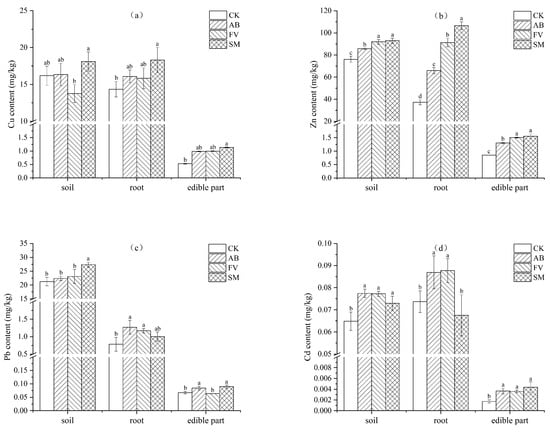
Figure 8.
(a) Cu concentration in soil and green pepper using the different treatments; (b) Zn concentration in soil and green pepper using the different treatments; (c) Pb concentration in soil and green pepper using the different treatments; (d) Cd concentration in soil and green pepper using the different treatments. Different lowercase letters at the top of the data in the same groups indicate significant differences between them at p < 0.05 level. CK, AB, FV, and SM refer to the different treatments.
The concentrations of the four heavy metals in the edible part of green pepper treated with SM were significantly larger than CK (p < 0.05), with Cu, Zn, Pb, and Cd concentrations reaching 0.83, 1.54, 0.090, and 0.0044 mg/kg, respectively. Zn and Cd concentrations in the edible part of vegetables treated with AB and FV were also significantly higher than CK (p < 0.05). However, the ratios of heavy metals in the roots and fruits of green pepper using the different treatments were similar.
3.4.2. Heavy Metal Concentrations in Eggplant
Zn and Pb concentrations in the roots of eggplant treated with AB and FV were significantly higher than CK (p < 0.05) (Figure 9b,c). These concentrations in samples treated with AB increased by 77.0% and 22.2%, and in samples treated with FV, they increased by 145.0% and 33.9%, respectively. Cu, Zn, and Pb concentrations in the eggplant roots treated with SM were also significantly higher than CK (p < 0.05) (Figure 9a–c), increasing by 32.1%, 186.1%, and 148%, respectively.
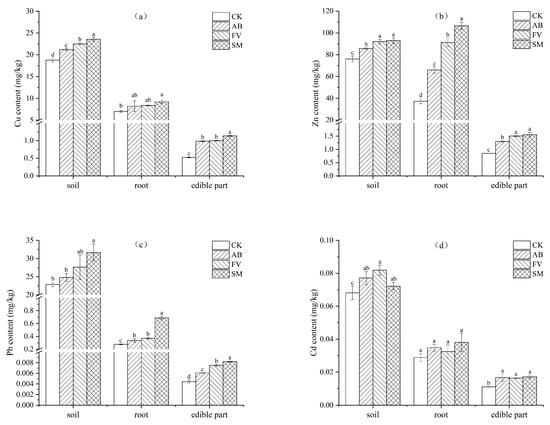
Figure 9.
(a) Cu concentration in soil and eggplant using the different treatments; (b) Zn concentration in soil and eggplant using the different treatments; (c) Pb concentration in soil and eggplant using the different treatments; (d) Cd concentration in soil and eggplant using the different treatments. Different lowercase letters at the top of the data in the same groups indicate significant differences between them at p < 0.05 level. CK, AB, FV, and SM refer to the different treatments.
Cu, Zn, Pb, and Cd concentrations in the fruit using the three fertilizer treatments were all significantly higher than CK (p < 0.05). These concentrations in the fruit treated with SM were the highest, which were 2.16, 1.83, 1.85, and 1.55 times CK, respectively. Root/fruit ratios of Cu, Zn, Pb, and Cd concentrations in the eggplant using the different treatments were similar.
3.4.3. Heavy Metal Concentrations in Brassica chinensis
The Cd concentration in the roots of Brassica chinensis treated with AB, FV, and SM was significantly higher than CK (p < 0.05) (Figure 10d), increasing by 127.6%, 153.5%, and 150.2%, respectively. The Pb concentration in the roots of Brassica chinensis treated with AB was significantly higher than CK (p < 0.05) (Figure 10c), increasing by 42.2%.
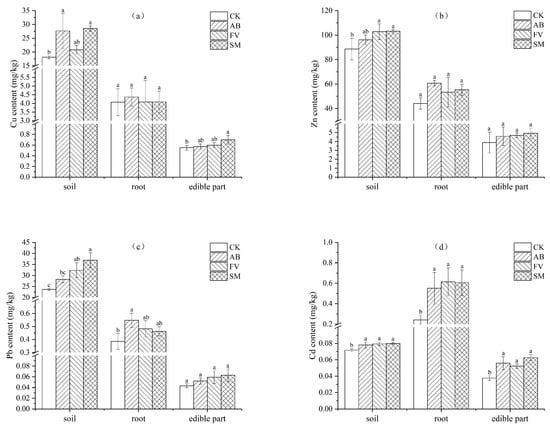
Figure 10.
(a) Cu concentration in soil and Brassica chinensis using the different treatments; (b) Zn concentration in soil and Brassica chinensis using the different treatments; (c) Pb concentration in soil and Brassica chinensis using the different treatments; (d) Cd concentration in soil and Brassica chinensis using the different treatments. Different lowercase letters at the top of the data in the same groups indicate significant differences between them at p < 0.05 level. CK, AB, FV, and SM refer to the different treatments.
The Cd concentration in the edible parts of Brassica chinensis treated with AB and FV was significantly higher than CK (p < 0.05) (Figure 10d), increasing by 48.5% and 39.1%, respectively. Cu and Cd concentrations in the edible parts of Brassica chinensis treated with SM were both significantly higher than CK (p < 0.05) (Figure 10a,d), increasing by 26.2% and 66.5%, respectively. Cu, Zn, Pb, and Cd concentrations in the edible parts of Brassica chinensis treated with swine manure, reaching 0.70, 4.92, 0.063, and 0.063 mg/kg, respectively, were higher than those in samples treated with the two mushroom residues.
3.4.4. Heavy Metal Concentrations in Lettuce
The Pb concentration in the roots of lettuce treated with AB was significantly higher than CK (p < 0.05) (Figure 11c), increasing by 89.4%. The Zn concentration in the roots of lettuce treated with SM was significantly higher than CK (p < 0.05) (Figure 11b), increasing by 109.7%.
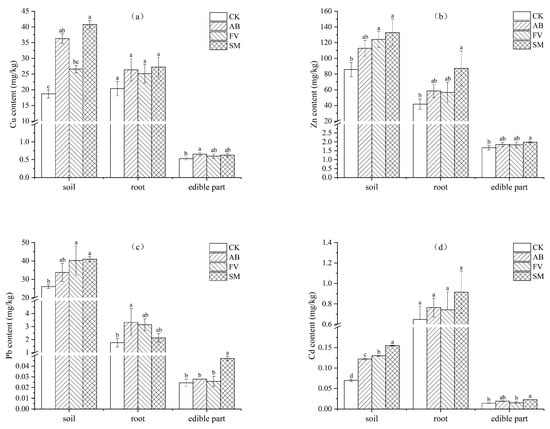
Figure 11.
(a) Cu concentration in soil and lettuce using the different treatments; (b) Zn concentration in soil and lettuce using the different treatments; (c) Pb concentration in soil and lettuce using the different treatments; (d) Cd concentration in soil and lettuce using the different treatments. Different lowercase letters at the top of the data in the same groups indicate significant differences between them at p < 0.05 level. CK, AB, FV, and SM refer to the different treatments.
The Cu concentration in the edible parts (leaves) of lettuce treated with AB was significantly higher than CK (p < 0.05) (Figure 11a), increasing by 86.2%. Zn, Pb, and Cd concentrations in the leaves of lettuce treated with SM were also significantly higher than CK (p < 0.05), increasing by 18.5%, 93.2%, and 62.5%, respectively. The Cu concentration in the leaves of lettuce treated with AB was the highest among the samples using the different treatments, reaching 0.66 mg/kg, and Zn, Pb, and Cd concentrations in the leaves of lettuce treated with SM were the highest, with 1.98, 0.047, and 0.023 mg/kg, respectively.
4. Discussion
4.1. Effects of Application of Mushroom Residues and Swine Manure on Soil Nutrients and Vegetable Yield
The organic matter content in the soils treated with AB, FV, and SM increased on average by 14.4%, 16.4%, and 17.6% with each vegetable rotation; TN increased by 17.7%, 22.7%, and 24.0%; AN increased by 16.0%, 19.5%, and 19.1%; TP increased by 65.3%, 67.9%, and 73.7%; AP increased by 39.3%, 41.6%, and 48.4%; TK increased by 9.5%, 12.6%, and 13.3%; AK increased by 20.5%, 34.0%, and 40.6%, respectively. The results highly suggest that the application of mushroom residues and swine manure significantly increased the contents of organic matter and mineral nutrients in the soils, which is consistent with many previous studies [33,34,35,36,37].
The yields of the four vegetables treated with AB, FV, and SM were significantly increased, compared with CK (p < 0.05) (Figure 6). Furthermore, a positive correlation was observed between the content of organic matter in the soils of vegetables and the yield of green pepper, eggplant, Brassica chinensis, and lettuce (r = 0.993, 0.981, 0.979, and 0.974, respectively, n = 12; p < 0.05), indicating that the increase in the yield of vegetables is attributed to the improvement in organic matter and nutrients in the soil. Mushroom residues are enriched in organic matter and mineral nutrients and can potentially be used as organic fertilizers [38,39]. Swine manure contains high levels of organic matter, mineral nutrients, and trace nutrients such as Cu and Zn and can improve the yield of crops more effectively [40].
4.2. Risk of Heavy Metal Accumulation in the Soils Treated with Mushroom Residues and Swine Manure
Feed additives are commonly used when raising livestock and poultry in farms to promote animal growth [41] and prevent animal diseases [42]. However, the additives in livestock and poultry feed usually contain a certain concentration of heavy metals, and most are finally excreted with animal manure [43]. In a previous study, 104 samples of animal and poultry feed were collected in Northeast China. The results revealed that the contents of Cu and Zn in chicken feed were 21.87 and 103.72 mg/kg on average, and those in pig feed were 117.70 and 135.88 mg/kg on average, respectively. Correspondingly, the contents of Cu and Zn in chicken manure were 87.14 and 384.15 mg/kg on average, and those in pig manure were 612.23 and 691.56 mg/kg on average, respectively [44]. Some types of animal manure even contain an excessive amount of Pb, Cd, As, and other toxic heavy metals [19,45]. Therefore, we should pay close attention to the possible accumulation of toxic heavy metals in organic fertilizers produced from animal manure [46].
The Cu concentration in swine manure was 5.21 times and 8.56 times the concentrations in the culture residues of Agaricus bisporus and Flammulina velutipes; the Zn concentration in the former was 4.18 times and 14.32 times the concentrations in the latter; the Pb concentration in the former was 2.04 times and 6.53 times the concentration in the latter; and the Cd concentration in the former was 1.50 times and 2.53 times the concentrations in the latter, respectively. Obviously, swine manure contained more toxic heavy metals than mushroom residues. Moreover, the residues of Agaricus bisporus were higher in heavy metal content than Flammulina velutipes, as the culture base of the former contains a certain amount of chicken manure (Table 3). The recycling of organic waste in fields not only increased the content of organic matter in soil but also leads to the accumulation of heavy metals, causing the transformation and migration of heavy metals in the environment [47]. There were significant positive correlations between the content of organic matter and Cu, Zn, Pb, and Cd concentrations in the soil samples (r = 0.840, 0.910, 0.923, and 0.721, respectively, n = 16; p < 0.01), indicating that the accumulation of heavy metals in soil can be attributed to the utilization of the organic waste.
Many previous studies reported that the continuous use of organic fertilizers leads to the contamination of heavy metals in soil [48,49,50]. The results of the field experiments in this study also indicate a continuous increase in heavy metals in the soils treated with AB, FV, and SM (Figure 7). The Cu concentration increased on average by 31.5%, 14.1%, and 39.4% at the time of each vegetable rotation; the Zn concentration increased by 10.5%, 14.9%, and 18.3% on average; the Pb concentration increased by 9.9%, 18.3%, and 19.2% on average; and the Cd concentration increased by 25.1%, 28.8%, and 40.7% on average, respectively. At the end of the experiments, the concentrations of heavy metals in the soils using the three fertilizer treatments were significantly higher than those in CK (p < 0.05), and they were increased even more significantly in samples treated with swine manure (Figure 7).
If the same pattern of cultivation and fertilization of vegetables in this field continues, heavy metals will accumulate in the plowing layers of the soil. The annual average increase rates of Cu, Zn, Pb, and Cd concentrations in the soils treated with AB were estimated to be 5.88, 9.03, 4.58, and 0.017 mg/kg, respectively. These concentrations will exceed the safety thresholds specified by the China National Standards for Food Safety (Cu ≤ 100 mg/kg; Zn ≤ 250 mg/kg; Pb ≤ 120 mg/kg; and Cd ≤ 0.3 mg/kg) (GB15618-2018) [51] if continuously applying the residues of Agaricus bisporus for 14, 18, 21, and 14 years. Likewise, the rates of increase in heavy metal concentrations in the soils treated with FV were, respectively, 2.64, 12.78, 4.75, and 0.020 mg/kg on average annually, and these will exceed the safety thresholds if continuously applying the residues of Flammulina velutipes for 31, 13, 20 and 12 years. For comparison, the rates of increase in heavy metal concentrations in the soils treated with SM were, respectively, as high as 7.36, 15.69, 5.00, and 0.028 mg/kg on average annually. Only after 11, 10, 19, and 8 years of the continuous application of swine manure would the concentrations of heavy metals in the soils exceed the safety thresholds. Obviously, the recycling of swine manure had a more significant effect on the increase in heavy metal concentration in the soils. The model to estimate the accumulation of heavy metals in soil resulting from the consecutive applications of organic fertilizers, however, is not ideal. In reality, the heavy metals transferred to the soil through fertilization may partially migrate to the soil’s deep layers or even leak out from the soil, thus reducing the risk of their accumulation in the layers used for cultivation. For example, the Cd accumulated in the soil due to the application of swine manure tends to migrate downward and thus poses a risk to groundwater [52].
In short, the concentrations of heavy metals in the soils of the four vegetable rotations showed an increasing trend due to the continuous application of mushroom residues and swine manure. Though the levels were still within safety limits, their continuous accumulation due to the long-term application of mushroom residues or swine manure may pose an environmental risk and should never be neglected.
4.3. Risk of Heavy Metal Accumulation in the Vegetables Treated with Mushroom Residues and Swine Manure
Vegetables are a necessity for humans’ daily diet. The consumption of vegetables, however, is a major source of heavy metal intake, which accounts for 90% of the total intake in humans [53,54]. The long-term consumption of metal-contaminated vegetables seriously harms human health [55]. As previously reported, after the application of mixed chicken and cow manure for 15 years, the Cd content in the soil exceeds the safety threshold specified by the China National Standards for Food Safety. The results also indicate that the Cd content in tomato and fennel growing in the soil is abnormally increased [56].
In our study, we found that Cu, Zn, Pb, and Cd concentrations in green pepper treated with SM were significantly higher than CK (p < 0.05), with 0.83, 1.54, 0.090, and 0.0044 mg/kg, respectively, and they were also higher than the concentrations in samples treated with AB and FV. Obviously, the application of swine manure increased the contents of heavy metals in the edible parts of green pepper more significantly.
Cu, Zn, Pb, and Cd concentrations in the edible parts of eggplant using the three fertilizer treatments were all significantly higher than CK (p < 0.05). These concentrations in samples treated with SM were 1.13, 1.56, 0.082, and 0.017 mg/kg, respectively. The contents of heavy metals in the edible parts of eggplant treated with SM were mostly significantly higher than samples treated with AB and FV (p < 0.05).
The Cd concentrations in the edible parts of Brassica chinensis treated with AB, FV, and SM were all significantly higher than CK (p < 0.05), reaching 0.056 mg/kg, 0.052 mg/kg and 0.063 mg/kg on average, respectively. The risk of Cd accumulation in Brassica chinensis via the application of mushroom residues and swine manure seems higher. This risk is even more serious with the application of SM and should be carefully considered.
Zn, Pb, and Cd concentrations in the edible parts of lettuce treated with SM were significantly higher than CK (p < 0.05), reaching 1.98, 0.047, and 0.023 mg/kg on average, respectively. This also indicates that the application of swine manure has a more significant effect, resulting in a higher accumulation of heavy metals in the edible parts of lettuce, and therefore it should be more carefully considered.
Moreover, a significant positive correlation was found between the contents of Cd and Zn in the edible parts of green pepper, eggplant, Brassica chinensis, and lettuce (r = 0.681, 0.881, 0.577, and 0.631, respectively, n = 16; p < 0.05), suggesting that the intake, transfer, and enrichment of Cd in the edible parts of vegetables may be associated with Zn [57].
As Cd is one of the most toxic metals, the accumulation and dietary intake of Cd is highly concerning. Comparing the different fertilizer treatments during the four vegetable rotations, it was found that the risk of Cd accumulation in the vegetables treated with SM was the highest. By comparison, the Cd concentration in the roots of vegetables showed a decreasing trend in the sequence of lettuce > Brassica chinensis > green pepper > eggplant, and this trend in the edible parts was in the sequence of Brassica chinensis > lettuce > eggplant > green pepper. Generally, the Cd concentration in leafy vegetables is much higher than that in fruits. The possibility of intake and accumulation of heavy metals in different plants is highly different [58,59,60]. The general trend, however, is leafy vegetables > root vegetables and vegetable stems > fruits [61].
After the first application of mushroom residues and swine manure, the BAF of Cd in the edible parts of green pepper was significantly increased, compared with CK (p < 0.05) (Figure 12d). After the second application, the BAFs of heavy metals in the edible parts of eggplant were all significantly increased (p < 0.05) (Figure 12). After the third application, the BAF of Cd in the edible parts of Brassica chinensis was significantly increased (p < 0.05) (Figure 12d). It was found that the toxic metal Cd more easily accumulated in the edible parts of green pepper, eggplant, and Brassica chinensis after the application of mushroom residues and swine manure.
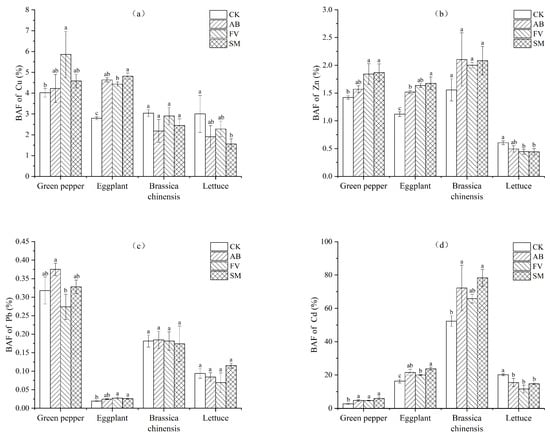
Figure 12.
(a) The BAF of Cu in the vegetables; (b) the BAF of Zn in the vegetables; (c) the BAF of Pb in the vegetables; (d) the BAF of Cd in the vegetables. Different lowercase letters at the top of the data in the same groups indicate significant differences between them at p < 0.05 level. CK, AB, FV, and SM refer to the different treatments.
According to the China National Standards for Food Safety (GB2762-2017) [62], the concentrations of toxic metals Pb and Cd in fruits should not exceed 0.1 mg/kg and 0.05 mg/kg, while those in leafy vegetables should be below 0.3 mg/kg and 0.2 mg/kg, respectively. Though Pb and Cd were slightly accumulated in the edible parts of the four vegetables using the different treatments in this study, the contents were still within safety levels. However, the trend of accumulation of toxic metals in vegetables with the long-term application of mushroom residues and swine manure should never be neglected.
5. Conclusions
The contents of organic matter and mineral nutrients in the soils were significantly increased after the continuous application of the two mixtures of mushroom residues and swine manure, thus increasing the yield of vegetables significantly. At the same time, however, the contents of heavy metals in the soils showed a trend of gradual increase. In particular, Cd was even more significantly increased in the soils after application. The content of organic matter was mostly significantly and positively correlated with that of heavy metals in the soils (p < 0.01), implying that the increase in heavy metal concentrations in the soils is mainly attributed to the application of the organic waste. Compared with the two mushroom residues, the application of swine manure poses a higher risk of heavy metal accumulation in the soil, as it contains a higher content of heavy metals.
The increase in heavy metal concentrations was also observed in vegetables after the persistent application of the organic waste, which was even more significant when using swine manure. Compared with other heavy metals, Cd more easily accumulated in the edible parts of vegetables when continuously applying the mushroom residues and swine manure. Although the concentrations of toxic heavy metals in vegetables were still within permissible levels during the four rotations, the increasing trend of their bioaccumulation should be carefully considered. Moreover, a better method is needed to prevent toxic metals from entering the food chain when recycling organic waste.
Author Contributions
X.H. conceptualized the study. W.L., Z.J. and S.L. developed the methodology. W.L., J.D. and X.W. conducted the investigation. C.L. analyzed the data and collaborated with X.H. in validating the data. C.L. wrote the original draft, and X.H. reviewed and edited the manuscript. Y.C. and X.H. supervised the project. All authors have read and agreed to the published version of the manuscript.
Funding
This study was financially supported by the Agriculture Research System of Shanghai, China (Grant No. 202209), and the Acting Plan for Science and Technology Innovation for Sustainable Development, Chongming District, Shanghai (No. CK2021-38).
Institutional Review Board Statement
Not applicable.
Informed Consent Statement
Not applicable.
Data Availability Statement
The data presented in this study are available upon request by the relevant authors.
Conflicts of Interest
The authors declare no conflict of interest.
References
- Qaswar, M.; Jing, H.; Ahmed, W.; Li, D.C.; Liu, S.J.; Zhang, L.; Cai, A.; Liu, L.S.; Xu, Y.M.; Gao, J.S.; et al. Yield sustainability, soil organic carbon sequestration and nutrients balance under long-term combined application of manure and inorganic fertilizers in acidic paddy soil. Soil Tillage Res. 2020, 198, 104569. [Google Scholar] [CrossRef]
- Guo, J.H.; Liu, X.J.; Zhang, Y.; Shen, J.L.; Han, W.X.; Zhang, W.F.; Christie, P.; Goulding, K.W.T.; Vitousek, P.M.; Zhang, F.S. Significant Acidification in Major Chinese Croplands. Science 2010, 327, 1008–1010. [Google Scholar] [CrossRef]
- Luo, F.; Yan, X.-J.; Hu, X.-F.; Yan, L.-J.; Cao, M.-Y.; Zhang, W.-J. Nitrate Quantification in Fresh Vegetables in Shanghai: Its Dietary Risks and Preventive Measures. Int. J. Environ. Res. Public Health 2022, 19, 14487. [Google Scholar] [CrossRef]
- Uphoff, N.; Dazzo, F.B. Making Rice Production More Environmentally-Friendly. Environments 2016, 3, 12. [Google Scholar] [CrossRef]
- Ye, L.; Zhao, X.; Bao, E.; Li, J.; Zou, Z.; Cao, K. Bio-organic fertilizer with reduced rates of chemical fertilization improves soil fertility and enhances tomato yield and quality. Sci. Rep. 2020, 10, 177. [Google Scholar] [CrossRef]
- Singh, S.; Maiti, S.K.; Raj, D. An approach to quantify heavy metals and their source apportionment in coal mine soil: A study through PMF model. Environ. Monit. Assess. 2023, 195, 306. [Google Scholar] [CrossRef]
- Gao, C.; El-Sawah, A.M.; Ali, D.F.I.; Alhaj Hamoud, Y.; Shaghaleh, H.; Sheteiwy, M.S. The Integration of Bio and Organic Fertilizers Improve Plant Growth, Grain Yield, Quality and Metabolism of Hybrid Maize (Zea mays L.). Agronomy 2020, 10, 319. [Google Scholar] [CrossRef]
- Menšík, L.; Hlisnikovský, L.; Pospíšilová, L.; Kunzová, E. The effect of application of organic manures and mineral fertilizers on the state of soil organic matter and nutrients in the long-term field experiment. J. Soils Sediments 2018, 18, 2813–2822. [Google Scholar] [CrossRef]
- Partey, S.T.; Preziosi, R.F.; Robson, G.D. Short-Term Interactive Effects of Biochar, Green Manure, and Inorganic Fertilizer on Soil Properties and Agronomic Characteristics of Maize. Agric. Res. 2014, 3, 128–136. [Google Scholar] [CrossRef]
- Sui, Y.; Jin, J.; Liu, X.; Zhang, X.; Li, Y.; Zhou, K.; Wang, G.; Di, G.; Herbert, S.J. Soil carbon sequestration and crop yield in response to application of chemical fertilizer combined with cattle manure to an artificially eroded Phaeozem. Arch. Agron. Soil Sci. 2017, 63, 1510–1522. [Google Scholar] [CrossRef]
- Beckers, S.J.; Dallo, I.A.; del Campo, I.; Rosenauer, C.; Klein, K.; Wurm, F.R. From Compost to Colloids—Valorization of Spent Mushroom Substrate. ACS Sustain. Chem. Eng. 2019, 7, 6991–6998. [Google Scholar] [CrossRef]
- Wang, C.; Wang, Y.; Ru, H.; He, T.; Sun, N. Study on Microbial Community Succession and Functional Analysis during Biodegradation of Mushroom Residue. BioMed Res. Int. 2021, 2021, 6620574. [Google Scholar] [CrossRef]
- Grujić, M.; Dojnov, B.; Potočnik, I.; Duduk, B.; Vujčić, Z. Spent mushroom compost as substrate for the production of industrially important hydrolytic enzymes by fungi Trichoderma spp. and Aspergillus niger in solid state fermentation. Int. Biodeterior. Biodegradation 2015, 104, 290–298. [Google Scholar] [CrossRef]
- Gobbi, V.; Nicoletto, C.; Zanin, G.; Sambo, P. Specific humus systems from mushrooms culture. Appl. Soil Ecol. 2018, 123, 709–713. [Google Scholar] [CrossRef]
- Ghirardini, A.; Grillini, V.; Verlicchi, P. A review of the occurrence of selected micropollutants and microorganisms in different raw and treated manure—Environmental risk due to antibiotics after application to soil. Sci. Total Environ. 2020, 707, 136118. [Google Scholar] [CrossRef]
- Vranješ, B.; Milićević, D.; Šefer, D.; Stefanović, S.; Ajtić, J.; Mitrović, B.M. Presence of natural radionuclides and toxic elements in monocalcium phosphate, complete feed and pig manure. Sci. Total Environ. 2020, 720, 137578. [Google Scholar] [CrossRef]
- Wang, C.; Zhang, M.; Wang, Z.Q.; Qian, X.Y.; Xu, C.; Ni, Y.Z.; Li, J.W.; Shen, G.X. Migration regularity and accumulation risk of heavy metals after continuous land application of swine manure in paddy soils. Acta Agric. Zhejiangensis 2022, 34, 1988–1997. [Google Scholar] [CrossRef]
- Atafar, Z.; Mesdaghinia, A.; Nouri, J.; Homaee, M.; Yunesian, M.; Ahmadimoghaddam, M.; Mahvi, A.H. Effect of fertilizer application on soil heavy metal concentration. Environ. Monit. Assess. 2010, 160, 83–89. [Google Scholar] [CrossRef]
- Yang, X.; Li, Q.; Tang, Z.; Zhang, W.; Yu, G.; Shen, Q.; Zhao, F.-J. Heavy metal concentrations and arsenic speciation in animal manure composts in China. Waste Manag. 2017, 64, 333–339. [Google Scholar] [CrossRef]
- Souri, M.K.; Hatamian, M.; Tesfamariam, T. Plant growth stage influences heavy metal accumulation in leafy vegetables of garden cress and sweet basil. Chem. Biol. Technol. Agric. 2019, 6, 1–7. [Google Scholar] [CrossRef]
- Wang, X.; Liu, W.; Li, Z.; Teng, Y.; Christie, P.; Luo, Y. Effects of long-term fertilizer applications on peanut yield and quality and plant and soil heavy metal accumulation. Pedosphere 2020, 30, 555–562. [Google Scholar] [CrossRef]
- Liu, C.-J.; Deng, S.-G.; Hu, C.-Y.; Gao, P.; Khan, E.; Yu, C.-P.; Ma, L.Q. Applications of bioremediation and phytoremediation in contaminated soils and waters: CREST publications during 2018–2022. Crit. Rev. Environ. Sci. Technol. 2023, 53, 723–732. [Google Scholar] [CrossRef]
- Chabukdhara, M.; Munjal, A.; Nema, A.K.; Gupta, S.K.; Kaushal, R.K. Heavy metal contamination in vegetables grown around peri-urban and urban-industrial clusters in Ghaziabad, India. Hum. Ecol. Risk Assess. Int. J. 2015, 22, 736–752. [Google Scholar] [CrossRef]
- Huang, Y.; Wang, L.; Wang, W.; Li, T.; He, Z.; Yang, X. Current status of agricultural soil pollution by heavy metals in China: A meta-analysis. Sci. Total Environ. 2019, 651, 3034–3042. [Google Scholar] [CrossRef]
- Raj, D.; Maiti, S.K. Risk assessment of potentially toxic elements in soils and vegetables around coal-fired thermal power plant: A case study of Dhanbad, India. Environ. Monit. Assess. 2020, 192, 699. [Google Scholar] [CrossRef]
- Lan, W.; Yao, C.; Luo, F.; Jin, Z.; Lu, S.; Li, J.; Wang, X.; Hu, X. Effects of Application of Pig Manure on the Accumulation of Heavy Metals in Rice. Plants 2022, 11, 207. [Google Scholar] [CrossRef] [PubMed]
- Qian, X.; Wang, Z.; Shen, G.; Chen, X.; Tang, Z.; Guo, C.; Gu, H.; Fu, K. Heavy metals accumulation in soil after 4 years of continuous land application of swine manure: A field-scale monitoring and modeling estimation. Chemosphere 2018, 210, 1029–1034. [Google Scholar] [CrossRef]
- Byers, H.L.; McHenry, L.J.; Grundl, T.J. Increased risk for lead exposure in children through consumption of produce grown in urban soils. Sci. Total Environ. 2020, 743, 140414. [Google Scholar] [CrossRef]
- Zhang, G.L.; Gong, Z.T. Soil Survey Laboratory Methods, 1st ed.; Science Press: Beijing, China, 2012; pp. 36–96. [Google Scholar]
- Varol, M. Assessment of heavy metal contamination in sediments of the Tigris River (Turkey) using pollution indices and multivariate statistical techniques. J. Hazard. Mater. 2011, 195, 355–364. [Google Scholar] [CrossRef]
- Maiti, S.K.; Nandhini, S. Bioavailability of Metals in Fly Ash and Their Bioaccumulation in Naturally Occurring Vegetation: A Pilot Scale Study. Environ. Monit. Assess. 2006, 116, 263–273. [Google Scholar] [CrossRef]
- Zhang, M.; Wang, P.; Lu, Y.; Lu, X.; Zhang, A.; Liu, Z.; Zhang, Y.; Khan, K.; Sarvajayakesavalu, S. Bioaccumulation and human exposure of perfluoroalkyl acids (PFAAs) in vegetables from the largest vegetable production base of China. Environ. Int. 2020, 135, 105347. [Google Scholar] [CrossRef] [PubMed]
- Chen, L.; Zhou, W.; Luo, L.; Li, Y.; Chen, Z.; Gu, Y.; Chen, Q.; Deng, O.; Xu, X.; Lan, T.; et al. Short-term responses of soil nutrients, heavy metals and microbial community to partial substitution of chemical fertilizer with spent mushroom substrates (SMS). Sci. Total Environ. 2022, 844, 157064. [Google Scholar] [CrossRef] [PubMed]
- Demelash, N.; Bayu, W.; Tesfaye, S.; Ziadat, F.; Sommer, R. Current and residual effects of compost and inorganic fertilizer on wheat and soil chemical properties. Nutr. Cycl. Agroecosystems 2014, 100, 357–367. [Google Scholar] [CrossRef]
- Piaszczyk, W.; Błoñska, E.; Lasota, J. Study on the effect of organic fertilizers on soil organic matter and enzyme activities of soil in forest nursery. Soil Sci. Annu. 2017, 68, 125–131. [Google Scholar] [CrossRef]
- Zhao, X.; Wang, J.W.; Xu, H.J.; Zhou, C.J.; Wang, S.Q.; Xing, G.X.; Goss, M. Effects of crop-straw biochar on crop growth and soil fertility over a wheat-millet rotation in soils of China. Soil Use Manag. 2014, 30, 311–319. [Google Scholar] [CrossRef]
- Zhou, J.; Wang, L.; Wang, H.; Jiang, L.; Jiang, X. Effects of different ratios of pig manure to fungus residue on physicochemical parameters during composting. J. Air Waste Manag. Assoc. 2016, 66, 499–507. [Google Scholar] [CrossRef]
- Ngan, N.M.; Riddech, N. Use of Spent Mushroom Substrate as an Inoculant Carrier and an Organic Fertilizer and Their Impacts on Roselle Growth (Hibiscus sabdariffa L.) and Soil Quality. Waste Biomass-Valoriz. 2020, 12, 3801–3811. [Google Scholar] [CrossRef]
- Vinogradov, D.V.; Zubkova, T.V. The use of organic fertilizers based on waste mushroom compost in agricultural crop production technologies. IOP Conf. Ser. Earth Environ. Sci. 2022, 1010, 012013. [Google Scholar] [CrossRef]
- Liu, D.Y.; Zhang, W.; Pang, L.L.; Zhang, Y.Q.; Wang, X.Z.; Liu, Y.M.; Chen, X.P.; Zhang, F.S.; Zou, C.Q. Effects of zinc application rate and zinc distribution relative to root distribution on grain yield and grain Zn concentration in wheat. Plant Soil. 2016, 411, 167–178. [Google Scholar] [CrossRef]
- Ding, H.; Zhang, Q.; Xu, H.; Yu, X.; Chen, L.; Wang, Z.; Feng, J. Selection of copper and zinc dosages in pig diets based on the mutual benefit of animal growth and environmental protection. Ecotoxicol. Environ. Saf. 2021, 216, 112177. [Google Scholar] [CrossRef]
- Zhang, R.; Gu, J.; Wang, X.; Li, Y. Antibiotic resistance gene transfer during anaerobic digestion with added copper: Important roles of mobile genetic elements. Sci. Total Environ. 2020, 743, 140759. [Google Scholar] [CrossRef] [PubMed]
- Xiong, X.; Yanxia, L.; Wei, L.; Chunye, L.; Wei, H.; Ming, Y. Copper content in animal manures and potential risk of soil copper pollution with animal manure use in agriculture. Resour. Conserv. Recycl. 2010, 54, 985–990. [Google Scholar] [CrossRef]
- Zhang, F.; Li, Y.; Yang, M.; Li, W. Content of Heavy Metals in Animal Feeds and Manures from Farms of Different Scales in Northeast China. Int. J. Environ. Res. Public Health 2012, 9, 2658–2668. [Google Scholar] [CrossRef] [PubMed]
- Sun, K.; Jiang, L.; Ye, Q.; Wang, Q.; Liao, D.; Chang, X.; Xi, S.; He, R. Chemical and microbiological characterization of pig manures and digestates. Environ. Technol. 2023, 44, 1916–1925. [Google Scholar] [CrossRef] [PubMed]
- Wang, H.; Dong, Y.H.; Wang, H.Y. Hazardous metals in animal manure and their changes from 1990 to 2010 in China. Toxicol. Environ. Chem. 2015, 96, 1346–1355. [Google Scholar] [CrossRef]
- Nakamaru, Y.M.; Matsuda, R.; Sonoda, T. Environmental risks of organic fertilizer with increased heavy metals (Cu and Zn) to aquatic ecosystems adjacent to farmland in the northern biosphere of Japan. Sci. Total Environ. 2023, 884, 163861. [Google Scholar] [CrossRef]
- Han, C.; Wu, L.; Tan, W.; Zhong, D.; Huang, Y.; Luo, Y.; Christie, P. Cadmium distribution in rice plants grown in three different soils after application of pig manure with added cadmium. Environ. Geochem. Health 2012, 34, 481–492. [Google Scholar] [CrossRef] [PubMed]
- Sprynskyy, M.; Kowalkowski, T.; Tutu, H.; Cozmuta, L.M.; Cukrowska, E.M.; Buszewski, B. The Adsorption Properties of Agricultural and Forest Soils Towards Heavy Metal Ions (Ni, Cu, Zn, and Cd). Soil Sediment Contam. Int. J. 2010, 20, 12–29. [Google Scholar] [CrossRef]
- Wang, J.; Yu, P.Y.; Cui, S.; Chen, X.; Shi, Y. Effect of greenhouse vegetable farming duration on Zinc accumulation in Northeast China. IOP Conf. Ser. Earth Environ. Sci. 2018, 113, 012159. [Google Scholar] [CrossRef]
- GB15618-2018; Environmental Quality Standards for Soils. Part 7.2: Level 2 of Environmental Quality Standards for Soil Inorganic Matter. Ministry of Ecology and Environment of the People’s Republic of China: Beijing, China, 2018. Available online: https://img.antpedia.com/standard/files/pdfs_ora/20200926/GB%2015618-2018.pdf (accessed on 23 April 2023).
- Wang, G.M.; Zhou, L.X. Erratum to: Application of Green Manure and Pig Manure to Cd-Contaminated Paddy Soil Increases the Risk of Cd Uptake by Rice and Cd Downward Migration into Groundwater: Field Micro-Plot Trials. Water Air Soil Pollut. 2016, 228, 155. [Google Scholar] [CrossRef]
- Mourato, M.P.; Moreira, I.N.; Leitão, I.; Pinto, F.R.; Sales, J.R.; Martins, L.L. Effect of Heavy Metals in Plants of the Genus Brassica. Int. J. Mol. Sci. 2015, 16, 17975–17998. [Google Scholar] [CrossRef] [PubMed]
- Ur Rehman, Z.; Khan, S.; Tahir Shah, M.; Brusseau, M.L.; Akbar Khan, S.; Mainhagu, J. Transfer of Heavy Metals from Soils to Vegetables and Associated Human Health Risks at Selected Sites in Pakistan. Pedosphere 2018, 28, 666–679. [Google Scholar] [CrossRef] [PubMed]
- Gupta, N.; Yadav, K.K.; Kumar, V.; Prasad, S.; Cabral-Pinto, M.M.S.; Jeon, B.-H.; Kumar, S.; Abdellattif, M.H.; Alsukaibia, A.K.D. Investigation of Heavy Metal Accumulation in Vegetables and Health Risk to Humans From Their Consumption. Front. Environ. Sci. 2022, 10, 791052. [Google Scholar] [CrossRef]
- Zhen, H.; Jia, L.; Huang, C.; Qiao, Y.; Li, J.; Li, H.; Chen, Q.; Wan, Y. Long-term effects of intensive application of manure on heavy metal pollution risk in protected-field vegetable production. Environ. Pollut. 2020, 263, 114552. [Google Scholar] [CrossRef]
- Zhou, H.; Yang, W.-T.; Zhou, X.; Liu, L.; Gu, J.-F.; Wang, W.-L.; Zou, J.-L.; Tian, T.; Peng, P.-Q.; Liao, B.-H. Accumulation of Heavy Metals in Vegetable Species Planted in Contaminated Soils and the Health Risk Assessment. Int. J. Environ. Res. Public Health 2016, 13, 289. [Google Scholar] [CrossRef]
- Abdallah, B.B.; Zhang, X.; Andreu, I.; Gates, B.D.; El Mokni, R.; Rubino, S.; Landoulsi, A.; Chatti, A. Differentiation of Nanoparticles Isolated from Distinct Plant Species Naturally Growing in a Heavy Metal Polluted Site. J. Hazard. Mater. 2020, 386, 121644. [Google Scholar] [CrossRef]
- Jambhulkar, H.P.; Juwarkar, A.A. Assessment of bioaccumulation of heavy metals by different plant species grown on fly ash dump. Ecotoxicol. Environ. Saf. 2009, 72, 1122–1128. [Google Scholar] [CrossRef]
- Tőzsér, D.; Magura, T.; Simon, E. Heavy metal uptake by plant parts of willow species: A meta-analysis. J. Hazard. Mater. 2017, 336, 101–109. [Google Scholar] [CrossRef]
- Huang, Z.; Pan, X.-D.; Wu, P.-G.; Han, J.-L.; Chen, Q. Heavy metals in vegetables and the health risk to population in Zhejiang, China. Food Control 2014, 36, 248–252. [Google Scholar] [CrossRef]
- GB2762-2017; National Standard for Food Safety, China. Limit of Pollutants in Food. National Health and Family Planning Commission: Beijing, China, 2017. Available online: https://kns.cnki.net/kcms/detail/detail.aspx?FileName=ZSPZ201803030&DbName=CJFQ2018 (accessed on 23 April 2023).
Disclaimer/Publisher’s Note: The statements, opinions and data contained in all publications are solely those of the individual author(s) and contributor(s) and not of MDPI and/or the editor(s). MDPI and/or the editor(s) disclaim responsibility for any injury to people or property resulting from any ideas, methods, instructions or products referred to in the content. |
© 2023 by the authors. Licensee MDPI, Basel, Switzerland. This article is an open access article distributed under the terms and conditions of the Creative Commons Attribution (CC BY) license (https://creativecommons.org/licenses/by/4.0/).